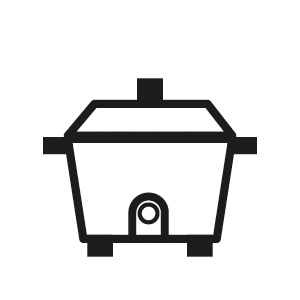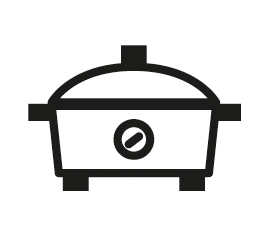








If you’re a Chocolate Person, you need to keep this stuff around. It could not be easier and it keeps in the fridge for a month. Ganache (say it: “guh-NOSH”) is the chameleon of all things sweet. Here are some of the ways to use it: Keep it in your rice cooker or slow cooker on the Warm setting for fondue to dip fruit, marshmallows, and chunks of cake into; stir a couple of generous tablespoons into a mug of nearly boiling milk for hot chocolate, or blend it into a Hack-uccino (this page); pour it, still warm, over a cake as a glaze or as hot fudge on ice cream; wait till it cools and use it as a frosting for cakes and cupcakes or sandwich it between peanut butter cookies (this page).
MAKES 1½ CUPS

8 ounces chopped semisweet chocolate (1 heaping cup)
1 cup heavy cream, at room temperature
In a glass or other microwave-safe bowl, microwave the chocolate at 30-second intervals, stirring after each interval, until the chocolate is melted. Add the cream and microwave for 30 seconds more. Remove the bowl from the microwave and gently whisk the cream and chocolate until completely smooth.
Use immediately, or let the ganache cool before storing, covered, in the fridge for up to 1 month.
Make it on the stove: Chop the chocolate finely. In a small saucepan, bring the cream to a boil. Immediately remove from the heat, add the chocolate (don’t stir), cover, and let sit for 10 minutes.
Stir gently with a whisk until combined and no white streaks remain. (If you whisk too vigorously, it will lose its shine—but it will still be good!)
Make it in a rice cooker: Turn on the rice cooker to the Cook mode and pour the cream into it. Cover and wait until the cream forms tiny bubbles ever so slightly around the edges, about 4 minutes.
Remove the pan from the rice cooker and add the chocolate to the hot cream. Cover again and let the cream and chocolate sit for 5 minutes. By this time, the chocolate will have melted in the heat of the cream. Whisk gently until no lumps remain.
Use immediately, or let the ganache cool before storing, covered, in the fridge for up to 1 month.
TIP Scoop little balls of the chilled ganache with a tiny ice cream scoop, roll in unsweetened cocoa powder, and voilà—chocolate truffles! Store them in the fridge until just before you’re ready to serve them.




It’s super simple to make peanut sauce that hits four of the six basic flavors: sweet, sour, salty, and umami—that difficult to describe, deeply savory one. This is the sauce used for the Bang Bang Chicken (this page), but you can also use it on hot or cold noodles, as a dip for Rice Paper Salad Rolls (this page), as a sauce for grilled chicken satay skewers, or as a dressing on salads. I like it on cucumbers with roughly chopped cilantro and red pepper flakes. Make a lot of it; it keeps for one month in the fridge.
MAKES 1½ CUPS

½ cup smooth peanut butter
3 tablespoons tamari or soy sauce
2 tablespoons apple cider vinegar or rice vinegar
2 tablespoons packed brown sugar
2 tablespoons toasted sesame oil
¼ cup hot water
In a medium bowl, whisk the peanut butter, tamari, vinegar, brown sugar, and sesame oil until completely smooth. Add the hot water, a little at a time, until incorporated.
Use immediately, or store the sauce in a covered jar at room temperature for up to 1 week, or refrigerated for up to 1 month. Bring to room temperature before using, or zap it in the microwave for about 15 seconds or so, until it loosens up.





Piri Piri Sauce is a true culinary collab; chiles from Africa, combined with paprika, vinegar, and garlic, the staples of Portuguese cooking. Here’s a bit of culinary anthropology for you: Fiery malagueta peppers were discovered in the Caribbean by Portuguese explorers in the fifteenth century. The voyage of Vasco da Gama in 1498 brought the Portuguese to Africa, along with the newly discovered chiles; they then grew wild for centuries. Piri piri chiles are descended from these, and are now cultivated commercially in Zambia, Uganda, Malawi, Namibia, and Zimbabwe. Use this for the Piri Piri Chicken Lollipops (this page), but also as a sauce for any meat, poultry, fish, or grain bowl, or simply as a dip.
MAKES 1½ CUPS

1 small red bell pepper, quartered; seeds and membranes removed
6 Fresno, cayenne, or red jalapeño chilies, halved; stems, seeds and membranes removed
4 garlic cloves
2 teaspoons kosher salt
2 tablespoons sweet smoked paprika
2 tablespoons apple cider vinegar or sherry vinegar
2 tablespoons extra-virgin olive oil
In a blender or bullet, combine the bell pepper, chilies, garlic, salt, paprika, vinegar, and olive oil and blend until smooth, stopping to scrape down the sides with a silicone spatula, about 30 seconds total.
Transfer the sauce to a glass jar and keep covered and refrigerated for up to 1 month.








I mean, you won’t take a bath in this Greatest of All Time sauce, but you’ll use it for everything else. Almost. My grandmother never didn’t have some of this around. It’s a simple, comforting sauce to ladle over pasta or simmer chicken pieces or cannellini beans in, with some spinach added at the end. With this on hand, Shakshuka (this page), One-Pot Pasta with Sausage & Broccoli (this page), and “Cheaters Never Prosper” Baked Ravioli Lasagne (this page) are a quick fix. An electric skillet or slow cooker is ideal for this; the sauce pretty much takes care of itself, except for the occasional stir and encouraging word from you.
MAKES ABOUT 3 CUPS

1 (28-ounce) can whole peeled tomatoes, squished up (use your hands)
2 garlic cloves, halved
1 medium onion, roughly chopped
¼ cup extra-virgin olive oil or 4 tablespoons (½ stick) unsalted butter (DON’T skimp; this is what makes it so good)
1 teaspoon kosher salt
Make it on the stove: In a large saucepan over medium heat, combine the tomatoes, garlic, onion, olive oil, and salt. Cover the saucepan and cook, stirring occasionally, until the onion and garlic are very soft and the sauce is thickened, about 1 hour. The fat will rise to the surface but just stir the sauce to blend everything again. Taste and season with additional salt, as desired.
You can either leave the sauce chunky, or let cool and blend with an immersion blender or transfer to a blender or food processor to blend to your desired texture.
The sauce will keep covered in the fridge for 1 week, or frozen for up to 2 months.
Make it in an electric skillet: Combine all of the ingredients in an electric skillet preheated to 300°F. Follow the directions above.
Make it in a slow cooker: Combine all of the ingredients in the slow cooker and set it to Low. Follow the directions above, but cook the sauce for 6 hours.








Go get a spoon, any spoon, and I’ll teach you the easiest way to peel ginger. Hold the spoon perpendicular to the ginger and scrape the ginger with the edge of the spoon. The outside layer will peel right off, even from the little nubbins. Now you’re ready to make this sweet, spicy, and tangy chutney. It’s good with soft cheese, as a spread on sandwiches (especially grilled cheese), as a condiment on rice and beans, or wrapped up with a ribbon as a gift. #skillz
MAKES 2½ CUPS

1 (15-ounce) can diced tomatoes
1 tablespoon peeled and grated ginger
1 small onion, chopped
2 garlic cloves, chopped
2 teaspoons garam masala
4 tablespoons apple cider vinegar or rice vinegar
¾ cup sugar
1 teaspoon kosher salt
¼ teaspoon cayenne, or more to taste
Combine the tomatoes, ginger, onion, garlic, garam masala, vinegar, sugar, salt, and cayenne in a medium saucepan and stir over medium heat until the sugar is dissolved, about 3 minutes. Taste and add more cayenne if you like it spicier.
Turn the heat up to maintain a gentle boil and cook for about 45 minutes, stirring every once in a while, until the chutney has thickened and is the consistency of jam.
Serve warm, or keep covered in the fridge for up to 2 months.
Make it in a rice cooker: Make sure your rice cooker has a capacity of at least 4 cups. Cook the chutney for one cycle on the Cook mode, stir, and cook it for another cycle, about 50 minutes total.
Make it in a slow cooker: Double or triple the recipe and cook it in a slow cooker on Low for 6 hours.




You’ll be tickled pink by how easy and delicious these are. They’re a puckery addition to everything from Falafel Burgers (this page), Keema (this page), Black Beans & Rice (this page), and Bollywood Butter Chicken (this page) to soups, salads, and my favorite: hot dogs.
MAKES ABOUT 2 CUPS

1 large red onion, thinly sliced
2 teaspoons kosher salt
⅔ cup distilled white vinegar
Dash of cayenne (optional)
In a medium bowl or a lidded jar, combine the onions and salt and toss gently to combine. Let the onions sit for about 30 minutes, until they start to “weep” (release their juices).
Add the vinegar and the cayenne (if using), cover, and let the onions continue to sit at room temperature for at least 2 hours. The longer they sit, the pinker they will become—it’s up to you!
The pickled onions can be kept covered in the fridge for up to 1 month.





A bit of trivia: 2 quarts of water take 10 minutes to come to a boil in a saucepan, or 3 minutes in an electric teakettle (and it turns itself off!). You can boil up to 6 eggs at a time this way, and then drink the water or use it to make tea or coffee. Eggshells have long been used as a water purifier, and the calcium and minerals that leach into the water from the eggshells help support healthy bones. #WinWin
SERVES 1

1 large egg
Fill an electric kettle a quarter of the way full with water and carefully lower an egg into it. Fill the kettle with additional water until the egg is covered by at least 1 inch.
Close the kettle and turn it on. After the kettle boils and rings, let the egg sit in the hot water for 3 to 4 minutes for a soft-boiled egg, 5 to 6 minutes for a jammy egg, and 7 to 9 minutes for hard-boiled.
Use a long spoon or tongs to remove the egg from the water, and run it under cold water.
TIP Eggs become easier to peel the older they get. To tell how fresh an egg is, put it in a glass of water: super fresh and it sinks to the bottom; less fresh but good to eat and it stands up on end but still touches the bottom; if it floats, it’s compost.